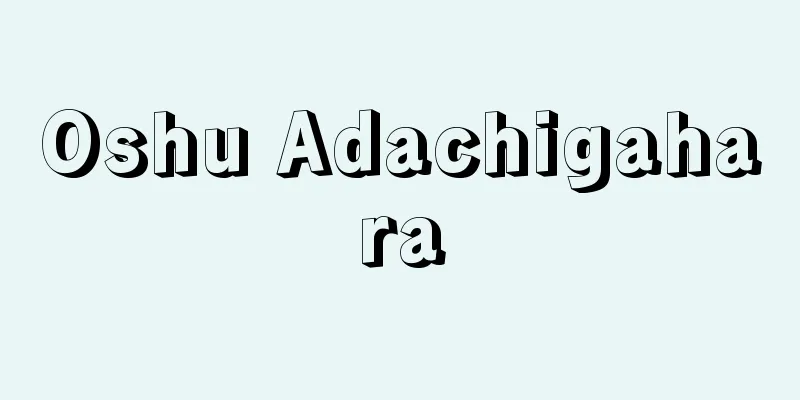Kenmu Restoration

|
A dictatorial government ruled by Emperor Godaigo from 1333 (Ganko 3, Shokei 2) to 1336 (Engen 1, Kenmu 3). [Kazuhiko Sato] Formation processWhen the uprisings of villains in the Kinai region and the Emishi rebellion in Oshu were making the Kamakura Shogunate's decline clear, Emperor Go-Daigo was making concrete plans to overthrow the Shogunate in order to resolve the serious conflict over the succession to the throne between the Daikakuji and Jimyoin lines and to realize direct imperial rule. The Emperor ascended to the throne in 1318 (Bunpo 2), and in 1321 (Genko 1), he abolished the cloistered government of Emperor Go-Uda and restored the Record Office. The Emperor appointed Yoshida Sadafusa, Madenokoji Nobufusa, Kitabatake Chikafusa, Hinosuketomo, Toshimoto, and others, and held meetings of Bureiko and Neo-Confucianism to plan the overthrow of the Shogunate. In September of the 24th year of the Shochu era (the 1st year of the Shochu era), the plan was leaked and the Rokuhara army attacked, resulting in a failure of the plan (Shochu Incident). However, the Emperor did not give in, and appealed to villainous groups in the Kinai and nearby provinces, samurai in the Imperial domain, outside vassals such as Ashikaga and Nitta who were critical of the Tokuso dictatorship, and warrior monks in Nanto and Hokurei to move the plan forward again. In April of the 31st year of the Genko era (1st year of the Genko era), the whole affair was exposed by the tip-off of Yoshida Sadafusa, and Hino Toshiki, Enkan, Monkan, and others were arrested by the Kamakura Shogunate forces. The Emperor barely escaped to Kasagi (Kasagi Town, Soraku County, Kyoto Prefecture) and called on local lords and bandits to join him in the campaign. Kusunoki Masashige, a local lord in Kawachi and the wealthy man of Sanjo, responded by raising an army at Akasaka Castle (Chihaya Akasaka Village, Minamikawachi County, Osaka Prefecture). However, within ten days, both Kasagi and Akasaka were overrun by the Shogunate's army, which was said to number 200,000, and the Emperor was captured and exiled to Oki in March of the following year (Genko Incident). Even while in Oki, the Emperor maintained contact with anti-Shogunate forces throughout the country, and in November 1332, Prince Moriyoshi succeeded in re-establishing his power in Yoshino, and Masanari in Chihaya Castle (Chihayaakasaka Village, Minamikawachi County). Prince Moriyoshi issued an imperial decree to overthrow the Shogunate to the monks of temples, local lords, and bandits in Kii, Iyo, and Harima. Thus, anti-Shogunate movements in various provinces rapidly gained momentum, and rebellions broke out one after another in various places. Taking advantage of this change in the war situation, in leap February of the 33rd year, the Emperor escaped from Oki and, with the help of Nagatoshi, a wealthy man from Nawanamiminato, Hoki (Daisen Town, Saihaku District, Tottori Prefecture), he based himself in Senjo-san and issued imperial decrees to various provinces to overthrow the shogunate. Ashikaga Takauji (Takauji) had been heading west as a shogunate general, but in late April, in response to Emperor Godaigo, he made his anti-shogunate stance clear and issued military urgings to powerful warlords throughout the country, such as the Yuki clan of Mutsu, the Ogasawara clan of Shinano, and the Shimazu clan of Satsuma, to join his army. The Ashikaga, Akamatsu, and Chigusa armies entered Kyoto and annihilated the Rokuhara army on May 7. In the eastern provinces, Nitta Yoshisada raised an army on May 8, marched to capture Kamakura, and toppled the Kamakura Shogunate on the 22nd. [Kazuhiko Sato] The beginning of the new government and its institutionsIn June 1333, the Emperor returned to Kyoto and issued an order to restore former territories, returning territories lost in the wars to their former owners and awarding honors to those who contributed to the overthrow of the shogunate. The Emperor looked back on the Engi and Tenryaku eras, namely the reigns of Emperors Daigo and Murakami, as ideal times, and began a despotic government with the pride of saying, "My new customs will set a precedent for the future." This was the so-called "Kenmu Restoration." To demonstrate his absolute authority, the Emperor promulgated the Individual Assurance Law, which stated that all land ownership could be confirmed and assured only by imperial edict. However, this law completely overturned the previous customs regarding land ownership, which provoked opposition from samurai from all over the country, and many of them came to Kyoto to seek confirmation of their territories, plunging Kyoto into chaos. The Emperor was forced to limit the application of this law to territories related to the Hojo clan, and changed it to the "Shokuho Equal Assurance Law," which required the confirmation of territories currently held by the emperor to be carried out by the provincial governors of each province. The various institutions of the Kenmu New Government were established in the center, including the Record Office, which handled lawsuits related to the assurance of land ownership, the Reward Office, which awarded meritorious service in various battles, the newly established Zasso Ketsudansho, which handled lawsuits related to disputes over administrative matters between manor lords and jito samurai due to the rampant activities of villains and the intensification of peasant struggles, unpaid taxes, and the Mushadokoro, which was responsible for guarding the Imperial Palace and Kyoto. The Zasso Ketsudansho, which dealt with land-related issues, was the most important of these, and was the fourth largest when it was established in early September 1333, but was changed to the eighth largest as the number of lawsuits increased. Even so, there were not enough staff to handle the rapidly increasing number of cases, and it was unable to do anything about the delays in litigation, as it was mocked as "a decision office with no skill, no room for moral people" ("Nijogawara Rakusho"). Kokuga (provincial offices) and shugosho (provincial governor offices) were established as local administrative institutions to maintain public order in each region. Shogunate offices were established in both Oshu and Kanto. In October 1600, Mutsu no Kami Kitabatake Akiie accompanied Prince Yoshiyoshi to Tagajo Castle (Tagajo City, Miyagi Prefecture), and in December Ashikaga Tadayoshi accompanied Prince Narinaga to Kamakura. In January of the following year, the Oshu Shogunate established the Shikihyojoshu (council of officials), Hikitsuke (official office), Mandokoro (administrative office), Samuraidokoro (samurai office), Bugyo (magistrate of temples and shrines), and Ando Magistrate, while the Kamakura Shogunate established the Kanto Stable Bureau to oversee the 10 provinces of Kanto. [Kazuhiko Sato] Contradictions in policies and the collapse of the governmentThe establishment of these two Shogun offices was the product of the feud between Emperor Go-Daigo and Ashikaga Takauji, which had begun immediately after the establishment of the Kenmu New Government. Although Takauji was appointed Governor of Musashi, he did not belong to any department of the Kenmu Government, and instead gathered samurai from all over the country at the magistrate's office he established after the successful overthrow of the shogunate. The conflict between the two gradually became more apparent. On January 29, 1334, the Emperor renamed the era Kenmu, announced the construction of the Daidairi (Great Palace) to demonstrate the Emperor's absolute authority, and made plans to mint coins (Kenkon Tsuho) and issue paper money. Furthermore, the head and lord positions of the Ichinomiya and Ninomiya of each province were abolished and placed under the direct control of the Emperor, checkpoints in each province were closed, and a Tokusei-rei decree was issued in May of the same year, but this did not have a sufficient effect. People were dissatisfied with the unfairness of the rewards, and resentment against the Kenmu government grew among the samurai who had been forced to pay the costs of building the Imperial Palace, and among the local farmers who had had that burden passed on to them, and the internal contradictions of the administration were becoming apparent. Farmers' complaints from Taranosho in Wakasa Province between May and August of that year, and graffiti at Nijogawara in August, were examples of criticism of the Kenmu Restoration by people all over the country. "Nijogawara Rakugaki" coldly captures the turbulent social climate under the Kenmu government, vividly describing how even after the new government was established, social order had not been restored at all, the lack of personnel in central institutions, and the state of rebellion and unruly behavior, even predicting the collapse of the Kenmu government. In October of the same year, Prince Morinaga, who was in conflict with Takauji, was arrested at the Imperial Court and imprisoned in Kamakura in December. In June of the following year, 1602, a plot by Gon Dainagon Saionji Kinmune and others to assassinate the emperor was revealed, and in July, Tokiyuki, the surviving son of the previous regent Hojo Takatoki, was supported by Suwa Yorishige and others and led an uprising in Shinano, attacking Kamakura and defeating the forces of Ashikaga Tadayoshi (the Nakasendai Rebellion). In August, Takauji traveled east to rescue Tadayoshi, defeated Tokiyuki's army, and recaptured Kamakura. The Emperor ordered him to return to Kyoto, but Takauji ignored the order and in November, he rebelled against the Kenmu government under the pretext of exterminating Nitta Yoshisada. The Ashikaga army, which defeated Nitta's army under the bamboo of Hakone, entered Kyoto in January of 1836 (1st year of Engen, 3rd year of Kenmu), but was defeated in the Battle of Kyoto and fled west to Kyushu. On the way, at a military council in Murotsu, Harima (Tatsuno City, Hyōgo Prefecture), it was decided to deploy the clan and powerful military commanders throughout Shikoku and Chugoku, and in Tomomotsu, Bingo (Fukuyama City, Hiroshima Prefecture), they received an imperial decree from the retired Emperor Kogon of the Jimyoin line, successfully avoiding the stigma of being enemies of the court. The Ashikaga forces, victorious in the Battle of Tatarahama (Higashi Ward, Fukuoka City) in Kyushu in March, marched east along the Sanyo Road and the Seto Inland Sea, and in May, they killed Masashige in the Battle of Minatogawa (Kobe City, Hyogo Prefecture), before returning to Kyoto. The Emperor fled to Mount Hiei, but returned to Kyoto at Takauji's urging, and in October, he handed over the sacred treasures to Emperor Komyo. In December, the Emperor made a secret visit to Yoshino and established the Southern Court, but it was no longer possible to recover from his political decline. [Kazuhiko Sato] "The History of the Northern and Southern Courts Period, by Tanaka Yoshinari (1922, Meiji Shoin)" ▽ "The Turmoil of the Northern and Southern Courts, by Sato Shinichi (1965, Chuokoron-Shinsha)" ▽ "Society and the People during the Medieval Civil War, by Nagahara Keiji (1977, Yoshikawa Kobunkan)" ▽ "A Study of the History of the Southern and Northern Courts Civil War, by Sato Kazuhiko (1979, University of Tokyo Press)" ▽ "The Kenmu Government, by Mori Shigeaki (Kyouikusha Rekishi Shinsho)" Source: Shogakukan Encyclopedia Nipponica About Encyclopedia Nipponica Information | Legend |
|
1333年(元弘3・正慶2)から36年(延元1・建武3)の間、後醍醐(ごだいご)天皇によって行われた専制政治。 [佐藤和彦] 成立過程畿内(きない)近国の悪党蜂起(あくとうほうき)、奥州の蝦夷(えぞ)反乱が、鎌倉幕府の衰勢を明白にしつつあったとき、大覚寺(だいかくじ)統と持明院(じみょういん)統との皇位継承をめぐる深刻な対立を止揚し、天皇親政を実現するために、後醍醐天皇は討幕の計画を具体化しつつあった。天皇は1318年(文保2)に即位し、21年(元亨1)後宇多(ごうだ)法皇の院政を廃して記録所を再興した。天皇は吉田定房(さだふさ)、万里小路宣房(までのこうじのぶふさ)、北畠親房(きたばたけちかふさ)をはじめ、日野資朝(ひのすけとも)・俊基(としもと)らを登用し、無礼講や朱子(しゅし)学の講書会を開いて討幕計画を練った。24年(正中1)9月、討幕の密計が事前に漏れて六波羅(ろくはら)軍の急襲を受けて計画は失敗した(正中(しょうちゅう)の変)が、天皇は屈せず、畿内近国の悪党集団、皇室領の武士、得宗(とくそう)専制に批判的な足利(あしかが)・新田(にった)らの外様御家人(とざまごけにん)、南都北嶺(なんとほくれい)の僧兵などに働きかけて再度計画を進めた。31年(元弘1)4月、吉田定房の密告によって事は露顕し、鎌倉幕府軍によって日野俊基、円観(えんかん)、文観(もんかん)らが逮捕された。天皇はかろうじて笠置(かさぎ)(京都府相楽(そうらく)郡笠置町)に逃れ、近隣の土豪・野伏らに参陣を呼びかけた。河内(かわち)の土豪で散所(さんじょ)の長者であった楠木正成(くすのきまさしげ)がこれに応じて赤坂(あかさか)城(大阪府南河内郡千早(ちはや)赤阪村)で挙兵した。しかし、20万と称される幕府の大軍によって笠置も赤坂も旬日のうちに蹂躙(じゅうりん)され、天皇は捕らえられて翌32年3月隠岐(おき)へ流刑となった(元弘(げんこう)の変)。 天皇は隠岐にあっても、全国各地の反幕府勢力と連絡を取り合い、1332年11月には護良(もりよし)親王が吉野(よしの)で、正成が千早城(南河内郡千早赤阪村)で再挙するのに成功した。護良親王は、討幕の令旨を紀伊・伊予・播磨(はりま)の寺院衆徒や土豪・野伏らに発した。こうして諸国の反幕府運動が急速に盛り上がり、各地で反乱が続発した。このような戦局の転換に乗じて、33年閏(うるう)2月、天皇は隠岐を脱出して、伯耆名和湊(ほうきなわみなと)(鳥取県西伯郡大山(だいせん)町)の長者名和長年(ながとし)の助けを受けて船上山(せんじょうさん)に拠(よ)り、討幕の綸旨(りんじ)を諸国に発した。足利高氏(尊氏)(たかうじ)は幕府の将として西上していたが、4月下旬には後醍醐天皇に応じて反幕府の旗色を鮮明にし、陸奥(むつ)の結城(ゆうき)氏、信濃(しなの)の小笠原(おがさわら)氏、薩摩(さつま)の島津氏など全国各地の有力武将に軍勢催促状を発して自軍への参加を要請した。足利軍、赤松軍、千種(ちぐさ)軍が京都に突入し、六波羅軍を壊滅させたのは5月7日のことである。東国においても5月8日に新田義貞(よしさだ)が挙兵し、長駆して鎌倉を攻略して、22日には鎌倉幕府を倒壊させた。 [佐藤和彦] 新政の開始と諸機構1333年6月、天皇は京都に帰り、旧領回復令を発して、戦乱のなかで失われた所領を旧所有者に返し、討幕の功労者への除目(じもく)を行った。天皇は延喜(えんぎ)・天暦(てんりゃく)の世、すなわち醍醐・村上(むらかみ)両天皇の治世を理想の時代として追慕し、「朕(ちん)ノ新儀(しんぎ)ハ、未来ノ先例タルヘシ」との自負のもと専制的な政治を開始した。いわゆる「建武中興」である。天皇はその絶対的な権威を示すために、土地の領有はすべて綸旨によってのみ確認され安堵(あんど)されるものであるという個別安堵法を公布した。しかし、この法令は、土地領有に関する前代以来の慣習を根底からくつがえすものであったから、諸国武士の反発を招き、所領安堵を求める武士たちが続々と上洛(じょうらく)して、京都は大混乱に陥った。天皇も当法の適用を北条(ほうじょう)氏関係の所領に限定せざるをえず、現に知行している所領の安堵については、諸国の国司(こくし)によって行うという諸国平均安堵法へと変更した。 建武新政府の諸機関としては、所領安堵に関する訴訟を取り扱う記録所、諸合戦の論功行賞を行った恩賞方、悪党の跳梁(ちょうりょう)や農民闘争の激化によって荘園(しょうえん)領主と地頭(じとう)武士との間で頻発していた所務相論、年貢未納などに関する訴訟を扱う新設の雑訴決断所(ざっそけつだんしょ)、皇居の警衛や京都の警備にあたった武者所(むしゃどころ)などが中央に設置された。なかでも所領問題の絡む雑訴決断所が重要であり、1333年9月の初旬に設置されたときには4番編成であったが、訴訟の増加につれて8番編成へと変更された。それでも激増する事務を処理するには職員は不足がちで、「器用ノ堪否(かんぷ)沙汰(さた)モナク、モルル人ナキ決断所」(「二条河原落書」)と嘲笑(ちょうしょう)されたように、訴訟事務の遅滞をどうすることもできなかった。 地方行政機関としては、国衙(こくが)と守護所(しゅごしょ)が置かれ、各地域の治安維持にあたった。奥州と関東にはそれぞれ将軍府が置かれた。33年10月には陸奥守(むつのかみ)北畠顕家(あきいえ)が義良親王を奉じて多賀城(たがじょう)(宮城県多賀城市)へと下向し、12月には足利直義(ただよし)が成良親王を奉じて鎌倉へと下っている。翌年正月、奥州将軍府には、式評定衆(しきひょうじょうしゅう)、引付(ひきつけ)、政所(まんどころ)、侍所(さむらいどころ)、寺社奉行(ぶぎょう)、安堵奉行が設置され、鎌倉将軍府には、関東10か国の管轄を目的とする関東厩番(うまやばん)が置かれた。 [佐藤和彦] 施策の矛盾と政権の崩壊両将軍府の設置は、建武新政府の成立直後から始まっていた後醍醐天皇と足利尊氏との確執の所産であった。尊氏は武蔵守(むさしのかみ)に任命されたものの、建武政府のどの部局にも属さず、討幕の成功時に開設した奉行所において全国各地の武士たちを糾合しつつあり、両者の対立はしだいに顕在化していった。1334年1月29日、天皇は年号を建武と改元し、天皇の絶対性を誇示するために大内裏(だいだいり)の造営を発表し、貨幣鋳造(乾坤通宝(けんこんつうほう))、紙幣発行などを計画した。さらに諸国一宮、二宮の本家職(ほんけしき)・領家職(りょうけしき)を停廃して天皇の直接支配下に入れ、諸国の関所を停止し、同5月には徳政令(とくせいれい)を発布したが十分な効果はあがらなかった。恩賞の不公平さに対する人々の不満、大内裏造営の費用を賦課された武士、さらにその負担を転嫁された地方農民の建武政府に対する反発がしだいに高まり、政権の内部矛盾も露呈しつつあった。この年の5月から8月にかけての若狭国(わかさのくに)太良荘(たらのしょう)の農民訴状や、8月の二条河原落書などは、全国各地の民衆の建武新政に対する批判の声であった。建武政権下の揺れ動く世相を冷徹な目でとらえた「二条河原落書」には、新政府になっても社会治安がすこしも回復しないこと、中央機関の人材不足、下剋上(げこくじょう)と自由狼藉(ろうぜき)のありさまが如実に描写され、建武政権の崩壊を予告すらしている。同年10月、尊氏と対立していた護良親王が宮中で捕縛され、12月には鎌倉に幽閉された。翌35年6月、権大納言西園寺公宗(さいおんじきんむね)らの天皇暗殺計画が露見し、7月には先の執権北条高時(たかとき)の遺子時行(ときゆき)が諏訪頼重(すわよりしげ)らに擁立されて信濃で蜂起(ほうき)し、鎌倉を攻撃して足利直義軍を破った(中先代(なかせんだい)の乱)。8月、尊氏は直義救援のために東下し、時行軍を敗退させ鎌倉を奪回した。天皇は帰京を命令したが、尊氏はこれを無視し、11月には新田義貞誅伐(ちゅうばつ)を名目に、建武政権へ反旗を翻した。新田軍を箱根竹の下で破った足利軍は、36年(延元1・建武3)正月に入京したが、京中合戦で敗れて西走し九州へ逃れた。この途中、播磨室津(むろつ)(兵庫県たつの市)の軍議で一族および有力武将を四国・中国の各地に配置することを決定し、備後鞆津(びんごとものつ)(広島県福山市)で持明院統の光厳(こうごん)上皇の院宣(いんぜん)を得て、朝敵の汚名を逃れることに成功した。3月九州多々良浜(たたらはま)(福岡市東区)の合戦で勝利した足利軍は、山陽道と瀬戸内海を東上し、5月、湊川(みなとがわ)(兵庫県神戸市)の合戦で正成を討ち死にさせ再度入京した。天皇は叡山へと逃れたが尊氏の強請により京都へ帰り、10月光明(こうみょう)天皇へ神器を渡した。12月、天皇は吉野へ潜幸して南朝を樹立したが、政治的退勢を挽回(ばんかい)することはもはや不可能であった。 [佐藤和彦] 『田中義成著『南北朝時代史』(1922・明治書院)』▽『佐藤進一著『南北朝の動乱』(1965・中央公論社)』▽『永原慶二著『中世内乱期の社会と民衆』(1977・吉川弘文館)』▽『佐藤和彦著『南北朝内乱史論』(1979・東京大学出版会)』▽『森茂暁著『建武政権』(教育社歴史新書)』 出典 小学館 日本大百科全書(ニッポニカ)日本大百科全書(ニッポニカ)について 情報 | 凡例 |
>>: Kenmu Code - Kenmushikimoku
Recommend
Taxodium
...This is probably due to the extinction of spec...
Wholesale - Grated Cucumber
This refers to sales between businesses that purch...
Colorful clouds
This phenomenon occurs when parts of cirrocumulus...
Samuel Clegg
1781‐1861 British gas engineer. Born in Manchester...
Shiose - Shioze
[1] In the early modern period, this was a fukusa ...
Bardem, JA (English spelling)
… One of the pioneers of Spanish cinema is the ca...
Denkan - epilepsy
Chinese playwright. Born in Changsha, Hunan Provi...
Kiyoshi Miki
Philosopher. Born on January 5, 1897, as the elde...
Biela's Comet
A comet discovered by Austrian W. Biela in 1772. I...
Fulda (English spelling)
A city in the state of Hesse in central Germany. I...
"Anekantajaya Patakha" - Anekantajaya Patakha
…Furthermore, he was extremely knowledgeable abou...
Anokumene (English spelling)
…the area on Earth where humans live permanently....
Arenaria serpyllifolia; sandwort
A delicate biennial plant of the Caryophyllaceae f...
Administrative contract - Gyosei Keiyaku
A contract between an administrative body and ano...
Guardian's Office - Shugosho
Locations of Shugokan from the Kamakura to Muromac...





![Yura [town] - Yura](/upload/images/67cd1568c9146.webp)



